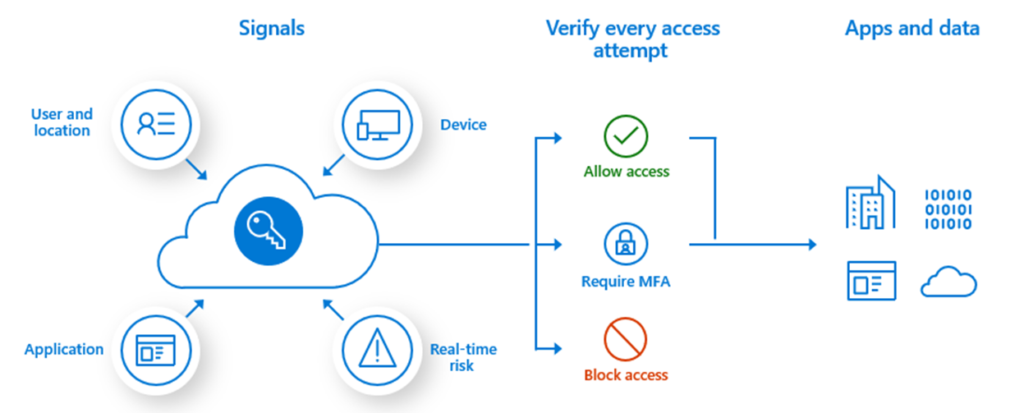IT trend 2023 is cybersecurity. Start with the individuals who enter your infrastructure and implement two-factor authentication Azure Active Directory.
If you follow the trends in the IT world, you probably haven't missed the fact that, in addition to the fact that we are entrusting more and more everyday activities and more complex tasks to artificial intelligence, cybersecurity is becoming a really "trendy issue". While the term "trendy" sounds a bit pejorative, it's a direction we applaud. Let's take a look at how Cybersecurity and what role two-step verification plays in it.
But the increased attention to cybersecurity did not come out of the blue. It is a response to increased number of cyber attacks. We had to start caring about security in cyberspace. Inaction would put our privacy, our assets, our sensitive data and the future of our business at risk. While cyber attackers used to be largely die-hard geeks who invented malware "for fun", today most of the time it's about data and money.

Benefits:
- Increased attention to cybersecurity and the use of multifactor authentication as a fundamental step to secure corporate infrastructure can reduce the risk of cyberattacks and secure sensitive data and company assets
- As a result of digitization and the need for companies to be online, attention must be paid to cyber security - only in this way can the risk of attacks be effectively reduced
- Azure Active Directory multi-factor authentication offers easy implementation and is very user-friendly, which can help improve the security of corporate infrastructure and minimize the risk of attacks
Cybersecurity needs to be kept in mind with digitalisation
The increased need to address cybersecurity at the corporate level is also as a result of digitalization. In recent years, the vast majority of larger and smaller companies have had to go digital. And this trend can be expected to continue. And that's why it's important to ensure that sufficient security. And it pays to proceed nicely from the individual when securing. You can secure your corporate infrastructure, but if every user doesn't adequately protect their access to it, your security is leaky as hell.
Secure your data from the individual - the key is a secure password and two-factor authentication
Instruct your employees and everyone who has access to your system to create secure password - long enough, combining different characters and unique. But even a great complex password needs an insurance policy. Set one up in your company mandatory two-step verification at login.
With multifactor authentication, users on your network will need to to log in with another action in addition to the password - by confirming it in the authentication app, by copying the code from the SMS message, etc. You don't have to worry about multi-factor authentication being new to your employees. Today, it is quite common when logging in to online banking, for example.
Multifactor authentication with azure active directory
Two-step verification Azure Active Directory helps protect access to data and applications and provides an additional "failsafe" to keep your data secure. You can implement multi-factor authentication with conditional access in your business, tailored to your specific needs. Don't underestimate the role that your employees play a role in your company's cybersecurity. All it takes is for a few of your employees to choose a company ERP the same login credentials they have for their private email, streaming service and coffee shop, and you're in trouble.
Increased attention to cybersecurity and the use of multifactor authentication as a fundamental step to secure corporate infrastructure can help companies reduce the risk of cyberattacks and secure sensitive data and assets of the organization.
By introducing two-step verification Azure Active Directory will eliminate the impact of weak or non-unique passwords. Because, let's face it - even the best training won't get all employees to create a secure password. Some will still keep their existing favorites - dog's name, date of birth, children's names...
The second "factor" in multifactor authentication is, as we say, either something you have, or something you've. Sounds mysterious, doesn't it? But it's not that mysterious. Something you have falls into the group of authenticating with some thing, like a cell phone or a dongle. Something that you're using directly the person of the user, it's like a fingerprint or a facial scan.
With Azure Active Directory multi-factor authentication, you can use the following other forms of verification:
- Microsoft Authenticator app
- Windows Hello for Business
- FIDO2 security key
- OATH Hardware Token (Preview)
- OATH software token
- SMS
- Voice call
IT infrastructure security must undoubtedly be comprehensive. Start with the individual and build security further. Don't build an impregnable fortress on a shaky foundation. Want more information about Azure Active Directory? Contact our specialists.

